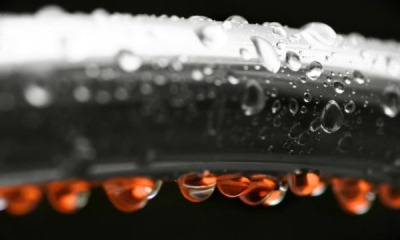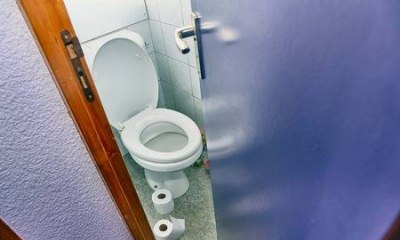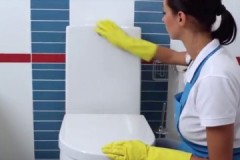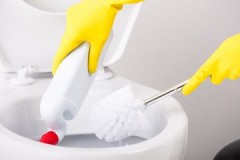Useful tips on how to remove condensation from cold water pipes in a toilet
 The formation of moisture on pipes with cold water in the toilet is not uncommon, especially in the winter season.
The formation of moisture on pipes with cold water in the toilet is not uncommon, especially in the winter season.
An unsightly unaesthetic appearance and constant dampness require determining the cause of this situation and solving the problem.
How to remove condensation from cold water pipes in the toilet, we will tell in the article.
Content
Causes of moisture droplets
Condensation can appear as small, almost invisible, droplets on the surface, or it can be so abundant in moisture that it even begins to drain onto the floor and form puddles. This poses a hazard to the room due to increased humidity.
In this case, water begins to absorb into the walls, destructively acting on the fasteners and the pipes themselves. And also lead to the appearance of mold in the toilet.
The main reasons for the problem:
- high humidity in the room;
- poor ventilation;
- lack of pipe insulation.
Control methods
Various approaches can be used to deal with condensation. The main directions are restoration of a normal microclimate with good ventilation in the toilet and thermal insulation of water supply lines.
Ventilation
In some cases, the formation of condensation is mainly due to insufficient ventilation in the toilet. To make sure of this, you can leave the door to the room not closed all night and analyze the condition of the pipes in the morning. If the experiment has shown that a previously wet surface has become more noticeable drier, then one cannot do without a solution to the issue of ventilation.
There are several approaches to the solution:
-
 Check if there is a 10-20 mm gap under the toilet door. It is necessary for air access to the toilet.
Check if there is a 10-20 mm gap under the toilet door. It is necessary for air access to the toilet.Ways to eliminate the flaw - reinstalling the door or embedding special ventilation valves into it, which provide air flow.
- Providing air flow from the street with more frequent ventilation. One of the options is the installation of a supply valve, which eliminates the problem without opening the windows (it can be installed both in the wall and in the frame).
- Installation of exhaust ventilation, which will effectively remove humid air from the toilet. Install the device, as a rule, half of a standard ventilation hole. The device can be turned on only when necessary, for example, after wet cleaning, and the rest of the time, ventilation will be carried out in standard mode.
- The easiest and fastest way to wick away excess moisture is to leave the toilet door ajar more often. This method can be used as a temporary one.
Thermal insulation
Good thermal insulation is a very effective method of eliminating condensation... This measure is aimed at eliminating the root cause of the appearance of water droplets on the pipe - the temperature difference between the water in the plumbing and the air in the toilet.
Before purchasing an insulating cover, you need to measure the length and diameter of the pipe on which you plan to put it on.
You can install the covers yourself according to the following algorithm:
- clean the surface of water supply lines from dust and dirt;
- if there is rust on the metal, it must be fought with before installing the thermal insulation;
- taking into account all pipe bends in the room, blanks are cut - separate for each straight section;
- on the covers there is a basting along which each workpiece must be cut;
- after cutting the blanks lengthwise, they are put on the pipes, bringing the edges of the longitudinal cuts by hand, without additional fixation;
- places of bends (turns) of pipes must be wrapped with electrical tape.
An alternative option is liquid insulation. The composition should be applied only to prepared metal pipes - cleaned and primed. The method of application is chosen convenient: by spraying, smearing with a brush. After the first layer has dried, the second is applied. The product dries quickly enough - about an hour.
Air humidity
Poor ventilation is not always to blame for high humidity in the toilet. The reasons may be as follows:
 The presence of leaks. This can be, for example, water constantly running out of the tank.
The presence of leaks. This can be, for example, water constantly running out of the tank.- When the toilet is combined with a bath - drying of wet linen.
- Lack (or complete absence) of heating devices. The solution is to install an additional coil.
- Complete filling of the coil with wet linen and rags. As a result, moisture evaporates even more. To prevent this, the heated towel rail and hot water pipes should be as free as possible.
Features of fixing the problem taking into account the material
The pipe material also plays a role in the fight against condensation. An important role in this is played by such an indicator as thermal conductivity. The lower it is, the less moisture accumulates on the surface of the pipes.
Metal
Metal pipes cool quickly when cold water passes through them. As a result, water vapor is attracted from the air, forming water droplets.
The water supply system, which uses metal pipes, needs additional thermal insulation. For this, a liquid agent is used or special covers are put on.
In case of wear of metal pipes, it is recommended to replace them with plastic.
Plastic
Plastic is much less moisture-attracting than metal... This is due to the lower thermal insulation of the material itself. But under unsuitable conditions, when the room is humid and very hot, the plastic surface can also become wet.
If protection from moisture is required, then thermal insulation is performed with profile covers.Another possible solution to the issue is to sew pipes into a protective plastic box, which insulates the water supply system from contact with humid air in the room.
Preventive measures
Using preventive measures will prevent the occurrence of the problem with condensation on pipes in the toilet:
 correct installation of the toilet door in compliance with the clearance or installation of valves;
correct installation of the toilet door in compliance with the clearance or installation of valves;- organization of a sufficient number of heating devices in the room;
- organization of good ventilation, including with an exhaust function;
- airing the room;
- elimination of a large number of wet things from textiles from a small room;
- elimination of leaks;
- keeping the room clean and airing the room after wet cleaning;
- organization of thermal insulation of cold water pipes;
- when installing highways, maintaining the distance between pipes with hot and cold water must comply with the standards and be at least 15 mm;
- sections of the entrance of communications with cold water to the toilet must be insulated.
6 tips to help
Expert advice will help in solving the problem:
- Liquid thermal insulation is applied only to dry pipes at room temperature.
- Before organizing thermal insulation, the surface must be prepared - free from rust, mold, etc.
- Half measures will not help solve the problem. For example, thermal insulation of pipes should be organized completely, without "bare" areas and gaps. Also, good ventilation will not completely solve the issue of condensation if there are leaks.
- The warmer the toilet room, and the greater the temperature difference between the water supply system and the air, the better and more reliable the thermal insulation should be.
- Rolled insulation is less practical in the conditions of the toilet room and is more difficult to install than profile insulation.
- If the source of the condensation problem is a riser running through the toilet room, it is recommended to cover it with thermal insulation and sew it into a box, which should not only be visually attractive, but also functional.
Related videos
How to eliminate condensation on cold water pipes, the video will tell you:
Conclusion
You can remove condensation from the cold water pipes in the toilet on your own. For this, an integrated approach should be used, combining thermal insulation, ventilation and maintaining a hygienic room with no water leaks.



